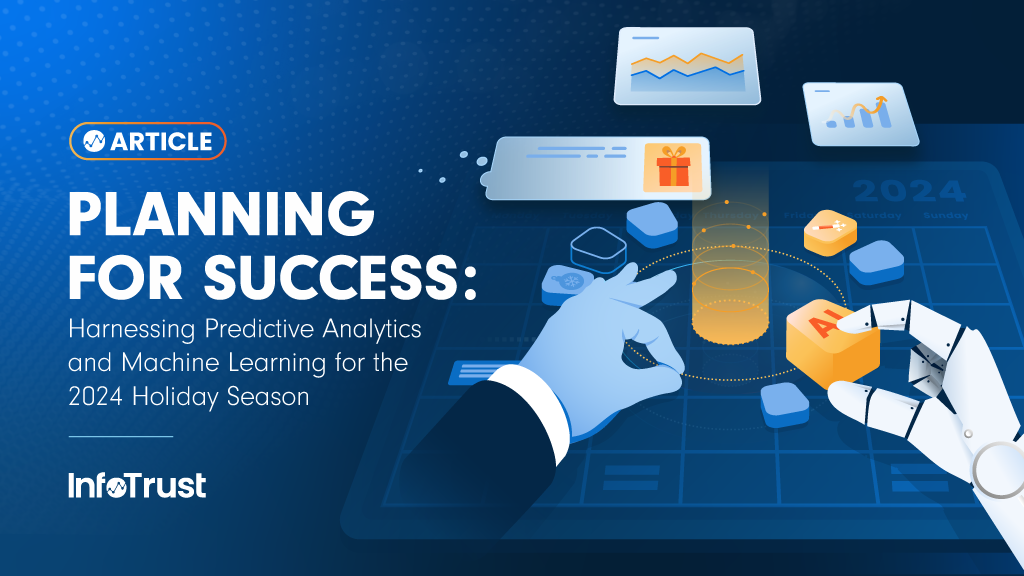The holiday season is a make-or-break period for many brands, underscoring the need for a comprehensive, sophisticated, and adaptable digital marketing strategy. With advancements in AI over the past few years, brands are now equipped to unlock a multitude of benefits, ranging from increased efficiencies to enhanced insights and media optimization. At InfoTrust, we recognize that for many of our B2C partners, the holiday shopping period can determine their performance for the entire year: according to the National Retail Foundation, on average, November and December sales have averaged approximately 19 percent of total retail sales over the last five years and can be higher for some retailers. As we approach the 2024 holiday season, it’s crucial to leverage predictive analytics and machine learning to elevate your marketing efforts. Here are several strategies our partners are implementing to harness the power of AI and achieve their year-end goals.
Predictive Audiences
Predictive audiences empower businesses to identify customers who are likely to convert based on relevant characteristics such as product preferences and spending habits. This approach is particularly effective during the holiday season for several reasons:
- Proactive Insights: Predictive audiences allow you to anticipate customer behavior across different segments, enabling you to tailor your messaging and offers accordingly.
- Stay Top of Mind: By sending personalized communications, your marketing team can ensure that your brand remains front and center during this busy time of year.
- Acquire Lookalike Customers: Leveraging predictive analytics can help you identify and attract new customers who resemble your highest-value clients, such as by using Lookalike segments in Google Ads.
- Increased ROI: By optimizing campaigns based on predictive insights, businesses can boost their return on investment by focusing on the most promising leads.
- Improved Customer Retention: By identifying high-value customers and understanding their behavior, businesses can create targeted strategies to keep these customers engaged and reduce churn.
Furthermore, utilizing capabilities like customer match offers a cookie-free targeting solution, allowing marketers to deliver impactful campaigns at scale in a cost-effective manner.
Common Types of Predictive Audiences to Consider in Your Marketing Strategy
- Propensity Modeling: This can enhance your retargeting efforts by identifying customers with a higher likelihood of conversion for various types of desired actions. Propensity models are highly flexible and can be utilized to predict the likelihood of any desired conversion—whether it’s a purchase, sign-up, or a specific online interaction, allowing you to adapt your strategy to various business objectives.
- Customer Lifetime Value (CLV): Understanding CLV can guide your retargeting strategies and help you acquire new customers, nurture relationships throughout different stages of the customer lifecycle, or improve efficiency by excluding customers from brand awareness and acquisition campaigns.
- Churn Modeling: Churn modeling not only helps prevent customer attrition but also enables marketers to identify customers who are likely to have churned, ensuring they aren’t included in campaigns which enhances overall campaign efficiency.
Bid Optimization in Search Ads 360 (SA360) or Google Ads
Value-based bidding (VBB) in SA360 and Google Ads utilizes sophisticated algorithms to optimize your bids based on the predicted value of customer conversions. Built directly into the platforms, these systems are designed to enhance campaign performance by aligning bidding strategies with specific business objectives. While features like Smart Bidding in Google Ads automatically adjust bids based on real-time factors such as device, location, and user behavior, the real competitive edge comes from how advertisers effectively leverage their first-party data to inform these algorithms.
By conducting thorough analyses of their own data—including previous interactions, purchase histories, and predicted future revenues—marketers can refine their bidding strategies to prioritize bids for the users most likely to engage and convert. For instance, it could mean adjusting bids to drive omnichannel sales or based on the long-term profitability of individual customers. Ultimately, value-based bidding not only taps into Google’s advanced technology but also customizes it to align with unique business goals, transforming a generic bidding approach into a precise, tailored strategy that maximizes return on investment and drives sustainable growth.
Forecasting
Forecasting is a quantitative approach to predicting future events based on historical data that enables businesses to make informed decisions in the present. It adds significant value across the organization, particularly during the holiday season, such as:
- Marketing Insights: The marketing team can leverage forecasts to assess whether they are on track to meet sales targets or if they need to adjust their strategies accordingly.
- Revenue and KPI Prediction: Forecasting helps predict revenue and other key performance indicators (KPIs), as well as the sales performance of individual products or entire product lines simultaneously. By comparing actual performance against forecasts, marketers can better evaluate campaign effectiveness, guiding future strategies and refining the forecasting process.
- Customizable Timeframes: Forecasts can be tailored to meet specific business needs, allowing for weekly, daily, or even hourly projections. This flexibility enables businesses to adopt a nimble approach when adjusting their sales or campaign strategies.
- Real-Time Optimization: By monitoring current-day trends, forecasting allows businesses to respond quickly and optimize their campaigns in real-time, improving the chances of meeting critical sales targets. For companies managing physical inventory, forecasting can alert them to significant spikes in sales, helping them manage their stock levels more effectively.
Common Types of Forecast Models to Consider in Your Marketing Strategy
- Real-time forecasts for revenue, transactions, users, or other KPIs: Real-time forecasts give marketers the visibility to know if they are on track to meet critical sales goals and if not, enable them to adjust their strategies sooner to increase the chances of meeting their targets.
- Demand forecasts at the product or category-level: Product and category-level forecasts are valuable to marketing teams for aligning their promotional strategies with expected sales.
Overall, forecasting enhances agility and empowers businesses with a proactive framework for optimizing their sales and marketing strategies.
Regression-Based Attribution
Regression-based attribution (RBA) is a valuable tool that can help marketers in two key ways: planning budgets ahead of the holiday season and attributing conversions to marketing campaigns after the holiday period has ended. By understanding the impact of their marketing tactics through RBA, marketers can derive insights that inform how their campaigns may perform in the future, enabling better planning and optimization.
As the digital landscape evolves—particularly with recent updates to user privacy laws, browser changes, and other regulations that limit marketers’ ability to connect with customers—it’s essential to adapt. We advise companies to invest in their own first-party data, ensure durable tagging practices are in place, and transition to attribution models that do not rely on third-party cookies. This is where regression-based attribution becomes particularly relevant, as it offers a more durable attribution method compared to traditional multi-touch models.
RBA helps businesses address crucial questions, such as:
- How do we attribute conversions to digital media for both offline and online sales in a world where cookies are becoming less effective?
- How do we continue to assess the contribution of one marketing tactic compared to another?
In addition to providing the typical insights of an attribution model—like attributed conversions—the regression-based attribution model can facilitate scenario planning, allowing marketers to optimize their campaigns. By forecasting the impact of adjustments to media budgets across various tactics, businesses can uncover opportunities for improvement in their current strategy. We recommend using these insights to conduct tests that objectively measure the lift in ROI from these optimizations, ensuring your campaigns are as effective as possible.
As we navigate the complexities of the 2024 holiday season, leveraging predictive analytics, machine learning, and advanced bidding strategies will be pivotal for brands striving to enhance their digital marketing effectiveness. By increasing campaign efficiency using predictive audiences, optimizing bids with data-driven insights, forecasting sales trends, and utilizing robust attribution methods, marketers can achieve a competitive edge. This proactive approach not only aids in achieving immediate sales goals but also sets the foundation for sustained growth in the evolving digital landscape. As brands invest in these strategies and refine their approaches, they position themselves to not only meet but exceed their year-end objectives, paving the way for continued success in the years to come.


